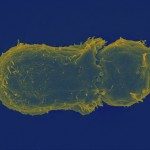Lien vers Pubmed [PMID] – 2576417
Immunol. Rev. 1989 Oct;111:111-44
The CD2 molecule is a 50-55KD transmembrane glycoprotein expressed on the vast majority of thymocytes and virtually all peripheral T lymphocytes. Its functions are two-fold: adhesion and activation. CD2 serves to facilitate conjugate formation between the T-lineage cell and its cognate partner via intermolecular interaction of CD2 and LFA-3 on the former and latter cells, respectively. Perturbation of the CD2 extracellular segment by certain combinations of anti-CD2 MAbs or LFA-3 and a single anti-CD2 MAb activate T-lineage function. These CD2-mediated activation events also synergize with signals mediated through the TCR to augment T-cell response. Based on microchemical analysis of immunoaffinity-purified human CD2 and cDNA and genomic cloning of mouse and human molecules, considerable structural information is now available. The mature surface human CD2 molecule consists of 327 amino acids: a 185 aa extracellular segment; a 25 aa hydrophobic transmembrane segment; and a 117 aa cytoplasmic domain rich in prolines and basic residues. The CD2 gene is comprised of five exons which span approximately 12 Kb on chromosome 1. A similar protein structure and gene exon organization is found for the mouse CD2 homologue. The CD2 adhesion domain is approximately 103 aa in length and is encoded by a single exon (exon 2). This domain is resistant to proteolysis, even though it lacks any intrachain disulfides and, like the entire extracellular segment protein expressed in a baculovirus system, binds to its cellular ligand, LFA-3. The latter occurs with a micromolar Kd. This relatively low affinity suggests that multivalent interactions among CD2 monomers on the T cells and individual LFA-3 structures on the cognate partner are important in enhancing the avidity of the T-cell interaction with its target or stimulator cell. The affinity of the CD2 extracellular segment for LFA-3 is not affected by truncations in the CD2 cytoplasmic domain, implying that ligand binding is not regulated by intracellular mechanisms. Given that CD2 mRNA expression and surface CD2 copy number are increased by more than one order of magnitude post-TCR stimulation, it is more likely that adhesion via CD2 is modulated by alteration in surface copy number. Analysis of early transduction events occurring via CD3-Ti (TCR) and CD2 including single channel Ca2+ patch-clamp recordings on living human T lymphocytes indicate a virtual identity of signals.(ABSTRACT TRUNCATED AT 400 WORDS)

